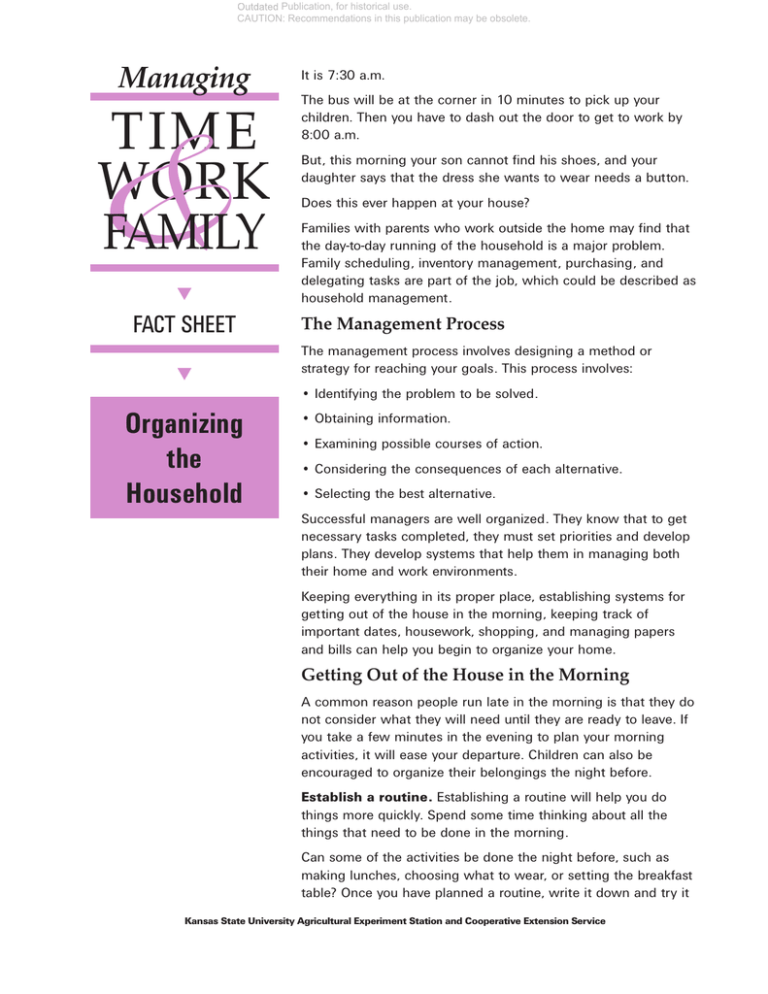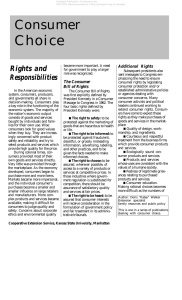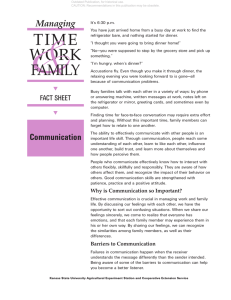
Outdated Publication, for historical use.
CAUTION: Recommendations in this publication may be obsolete.
Managing
TIME
WORK
FAMILY
&
▼
FACT SHEET
▼
It is 7:30 a.m.
The bus will be at the corner in 10 minutes to pick up your
children. Then you have to dash out the door to get to work by
8:00 a.m.
But, this morning your son cannot find his shoes, and your
daughter says that the dress she wants to wear needs a button.
Does this ever happen at your house?
Families with parents who work outside the home may find that
the day-to-day running of the household is a major problem.
Family scheduling, inventory management, purchasing, and
delegating tasks are part of the job, which could be described as
household management.
The Management Process
The management process involves designing a method or
strategy for reaching your goals. This process involves:
• Identifying the problem to be solved.
Organizing
the
Household
• Obtaining information.
• Examining possible courses of action.
• Considering the consequences of each alternative.
• Selecting the best alternative.
Successful managers are well organized. They know that to get
necessary tasks completed, they must set priorities and develop
plans. They develop systems that help them in managing both
their home and work environments.
Keeping everything in its proper place, establishing systems for
getting out of the house in the morning, keeping track of
important dates, housework, shopping, and managing papers
and bills can help you begin to organize your home.
Getting Out of the House in the Morning
A common reason people run late in the morning is that they do
not consider what they will need until they are ready to leave. If
you take a few minutes in the evening to plan your morning
activities, it will ease your departure. Children can also be
encouraged to organize their belongings the night before.
Establish a routine. Establishing a routine will help you do
things more quickly. Spend some time thinking about all the
things that need to be done in the morning.
Can some of the activities be done the night before, such as
making lunches, choosing what to wear, or setting the breakfast
table? Once you have planned a routine, write it down and try it
1
Kansas State University Agricultural Experiment Station and Cooperative Extension Service
Outdated Publication, for historical use.
CAUTION: Recommendations in this publication may be obsolete.
for a few days. Following a trial period, make any necessary
adjustments.
Other suggestions. You might also:
• Pack your purse and briefcase in the evening and leave them
by the front door.
• Establish a place where your keys are always kept.
• Stay with the task you start. Do not hop from room to room as
you get ready in the morning. Stopping to fix the children their
breakfast, while in the middle of getting dressed, wastes time.
If your children are too young to make their own breakfast,
consider getting up early enough to get dressed before
starting breakfast.
Important Dates and Times
Family calendar. A large family calendar can help you keep
track of important times, dates and events. Stress the
importance of writing down their activities to each family
member, so that the whole family will know what is going on.
Parents and older children should remember to transfer
important dates to their own personal calendar.
When choosing a calendar, get one with spaces that are large
enough to write information and record appointments. There
should be ample space for notes, and possibly a list of telephone
numbers.
Bills, cards and correspondence. To help get bills, cards and
correspondence out on time, you could:
• Establish a regular time each month to review upcoming dates
and shop for cards or gifts.
• Purchase a variety of cards, or get blank cards and write your
own message.
• Address and sign each card. Write the date they are to be
mailed in the corner where the stamp should go.
• Stack the cards in a basket by the door and mail them when
necessary.
Housework
Housework is another key area in which improved organizational
skills can be beneficial. Planning is the key to a low-maintenance
home.
In this case, as in others, you have to stand back and look at
your situation with new eyes. Most of us get so used to our
home environment and our usual way of doing things, that we
do not notice what needs changing.
2
Outdated Publication, for historical use.
CAUTION: Recommendations in this publication may be obsolete.
Unnecessary items. One of the first things that can be done to
minimize housework is to get rid of unnecessary items.
• Eliminate all unused equipment and clothing, impractical
furniture and temperamental houseplants.
• Have a garage sale or donate items to your local thrift shop or
emergency shelter.
Storage. Once you have disposed of excess baggage, make sure
you have the best storage you can create.
Ask yourself the following questions:
• Are the right items stored here?
• How can this space be made more useful?
• Would dividers, bins or half-shelves be useful?
• Do I need to increase the actual storage space by adding a
new shelf, etc?
• What can I do right now to eliminate obvious clutter and
messiness?
Other suggestions. Other suggestions for managing
housework include:
• Set up a practical maintenance schedule for you and your
family. One benefit of designing a maintenance schedule is
that once you have established a routine, you move with
greater speed. Post a reminder list of chores in each room.
•Put together a carry-along kit with the supplies you will need
for most clean-up tasks. Take it with you as you work in each
room.
• Give yourself five minutes to work in each room. Prioritize and
do the important things first. Experiment to see what will work
best for you.
• Leave an area as you found it. Get used to always putting
things away when you are finished using them.
Shopping
The key to organized shopping is developing a good list of
everything that you need.
When doing general shopping, organize your list around your
schedule for the day. If you are on one side of town to attend a
meeting, make sure to pick up any supplies you need from shops
on that side of town.
3
Master list. When going grocery shopping, it can be helpful to
develop a master list of the things that you buy. Once you have a
good list, photocopy it and keep copies where they can be easily
found.
Outdated Publication, for historical use.
CAUTION: Recommendations in this publication may be obsolete.
When making a list for grocery or other shopping, write down
everything that you need to pick up. Don’t trust your memory!
It is also important to teach family members to routinely jot down
items on the shopping list when they are low—not out.
Other suggestions. Additionally you can:
• Plan all your meals at least one week in advance. Start making
a list of the ingredients you will need so that you can pick
them up on your next shopping trip.
• Try to minimize the number of trips to the store. Buy supplies
in multiples (three boxes of cereal, two rolls of tape).
• Shop in bulk—buy as much as you can store. Shopping once
per week or month will cut down on your impulse buying.
Papers and Bills
Keeping track of important papers and bills is a troublesome area
in many families. Ultimately you want to be able to easily find
any paper when you want it.
Home business center. Establishing a home business center is
one of the first things you can do to help manage your
paperwork.
This center can be in any room of the house, and should have
adequate lighting; a waste basket; a box or letter holder for
incoming mail; a desk, table or countertop for writing checks and
making lists; a drawer or box for small supplies (pencils, pens,
etc.); and a file drawer or file box for storage.
Other family members should be familiar with the center and
should be able to locate any information in case the primary
bill-payer is out of town or ill.
Handling day-to-day papers. After establishing work and
storage space of some kind, you are ready to develop a system of
handling day-to-day papers and records. One way is to use a bill
holder with pockets to separate unpaid and paid bills. Bills go
into the “pay” envelope when they are received, and when they
are paid they go into the “file” envelope for eventual storage.
A loose-leaf notebook or household operating manual is another
system for organizing materials. The notebook can have sections
or pockets for bills to be paid, receipts to be filed, warranty
information, etc.
When information is needed, you can pick up the entire manual
and flip to the correct section and page. Because of the manual’s
bulk, remember to return it to its original location.
4
Outdated Publication, for historical use.
CAUTION: Recommendations in this publication may be obsolete.
Storing valuables and documents. Each of us has valuables
which should be kept in a fire-proof, theft-proof storage space—
either a home safe or a bank safe deposit box. Many documents
are difficult, if not impossible, to replace. It is important to store
valuables and documents in a safe place.
Other tips.
• File important papers regularly. Choose a basket or a “to file”
folder to hold your papers that are waiting to be filed. Establish
a set time to file—at least once per week. Do not let your
papers pile up!
• Instead of asking yourself, “Could I possibly use this one day?”
ask “What is the worst thing that could happen if I throw this
out?”
If the answer is nothing serious, toss it.
Conclusion
Organizing a home requires time and energy, but pays off quickly.
Thinking through problems which keep your home from running
smoothly, looking at alternative solutions, and choosing the best
methods are steps in the home management process.
You can begin to organize your home by establishing systems for
getting out of the house in the morning, keeping track of
important dates, housework, shopping, and managing papers
and bills.
Sources
DEVELOPED BY THE “MANAGING
TIME, WORK AND FAMILY” TEAM:
Eisenberg, Ronni. Organize Yourself. New York: MacMillan
Publishing Company,1986.
Katey Walker, Extension Specialist, Family
Resources & Public Policy
Emily Mark, Extension Specialist, Family &
Consumer Sciences, Northeast
Laurie Chandler, CED, Shawnee Co.
Fran Richmond, CEA, FACS, Osage Co.
Denise Sullivan, CEA, FACS, Leavenworth Co.
Jones, Joyce. Developing a Household Operating Manual.
Manhattan, Kansas: Cooperative Extension Service, Kansas
State University, February 1984.
and Support Staff
Thomas, Natalie. Getting Organized Series. Fairbanks, Alaska:
Cooperative Extension Service, University of Alaska.
5
Lew, Irvina Siegel. You Can’t Do It All. New York: Atheneum,1986.
Outdated Publication, for historical use.
CAUTION: Recommendations in this publication may be obsolete.
Contents of this publication may be freely reproduced for educational purposes. All other rights are reserved. In each case, credit Emily Mark & Katey Walker, “Managing Time, Work & Family,”
Kansas State University, December 1997.
Kansas State University Agricultural Experiment Station and Cooperative Extension Service, Manhattan, Kansas
MF-2254
December 1997
Issued in furtherance of Cooperative Extension Work, acts of May 8 and June 30, 1914, as amended. Kansas State University, County Extension Councils, Extension Districts, and United States
Department of Agriculture Cooperating, Richard D. Wootton, Associate Director.
It is the policy of Kansas State University Agricultural Experiment Station and Cooperative Extension Service that all persons shall have equal opportunity and access to its educational programs,
services, activities, and materials without regard to race, color, religion, national origin, sex, age or disability. Kansas State University is an Affirmative Action employer. These materials may be
available in alternative formats.
File Code: Family Resource Management—4
CS 12/97—150
6





